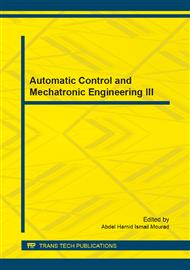p.248
p.255
p.259
p.265
p.270
p.276
p.282
p.286
p.290
Gliding Trajectory Optimization Method Based on Particle Swarm Optimization and Direct Shooting Method
Abstract:
Glide trajectory optimization of vehicle can greatly improve the performance of missile. As is well-known, methods of trajectory optimization can be divided into direct and indirect methods. Generally, the direct method is convenient and can obtain the optimal solution with higher probability. Based on the direct method, a missile trajectory is optimized by discretizing the control quantity (angle of attack) and transforming the original optimal control problem to a nonlinear programing problem (NLP) in the present paper. The particle swarm optimization algorithm that is easy to implement and has higher convergence rate is utilized to solve the transformed NLP to generate the optimal angle of attack rule. Simulation results show that with the optimal rule, gliding distance of missile is clearly improved compared to the initial one.
Info:
Periodical:
Pages:
270-275
Citation:
Online since:
August 2014
Authors:
Price:
Сopyright:
© 2014 Trans Tech Publications Ltd. All Rights Reserved
Share:
Citation:


